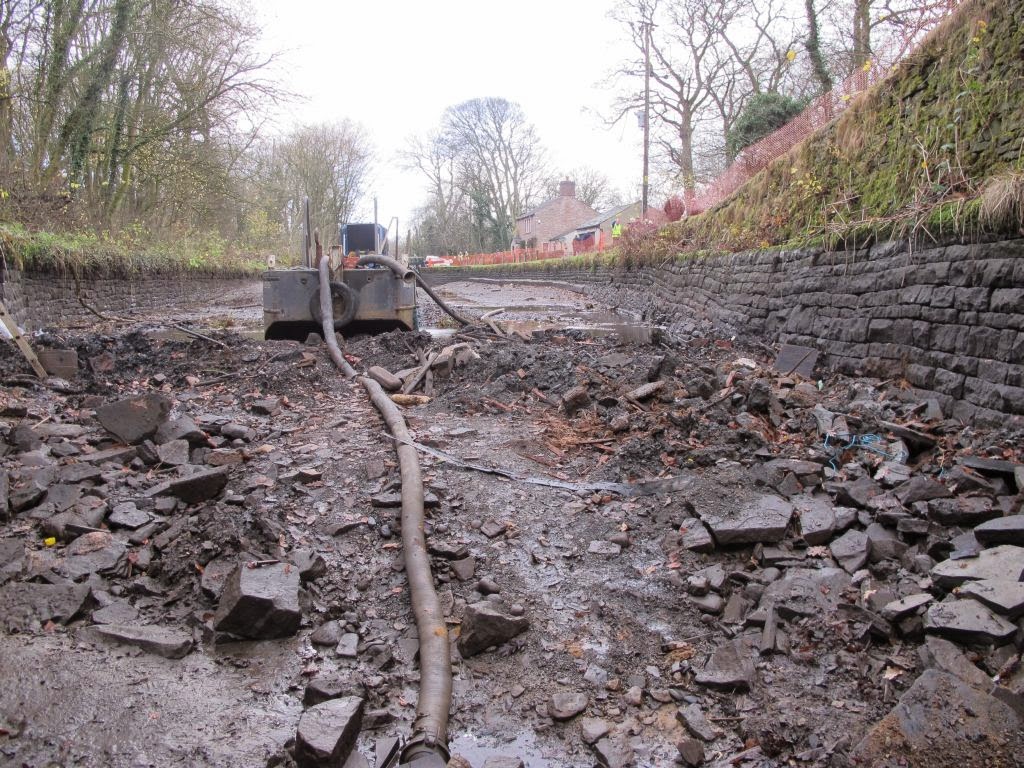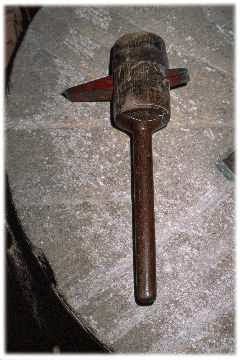Samuel Oldknow's Mellor Mill, burned out in 1892
Bob told us of the Mellor Archaeological Trust's efforts to gain a Heritage Lottery Fund (HLF) Grant. Their first application was not successful so they tried again. Their second application also failed, but only because the Canal & River Trust had also put in a bid for HLF funding for the restoration of Marple Aqueduct. The HLF advised the Archaeological Trust and the Canal & River Trust that as both projects were in the same locality, and both concerned Samuel Oldknow (who had been active in promoting the Peak Forest Canal both for his mill and for his lime industry at Marple), they should submit a joint £2.3 million bid entitled ‘Revealing Oldknow’s Legacy'. This they did, and were successful. Early next year our Local History Group will visit the site of Mellor Mill so Bob can show us around. In the meantime, he told us of today's event which is concerned with the Canal & River Trust's part of the joint project, so I went along to have a look.
The works at Marple Aqueduct are supported by a £1.5 million share of the HLF 'Oldknow' funding, together with public donations. ‘Revealing Oldknow’s Legacy' aims to revive the legacy of one of the leading industrialists of the early cotton industry, by protecting and opening up three important historic sites he was closely associated with; Marple Aqueduct, Mellor Mill and Marple Lime Kilns.
While the Canal & River Trust is repairing Marple Aqueduct, they are also doing maintenance work on the number two lock in the Marple flight, as this has been leaking water. Today's open day concerned both work on the lock, and on the aqueduct.
As usual, please click on any picture for a larger image.
It's about a mile walk from the road by lock 9 at Marple down the flight to lock 2 where the work was taking place, but it was bright and dry today, pretty good for the last day of November, so the walk was enjoyable
Not only was the lock and pound below it drained, but the Canal & River Trust had cleared the debris out of it and set up a stairway so visitors could easily gain access
The floor and lower sides of the lock are brick, the remainder built in stone
The lock gates are about 15 years old and have another 10 years or so of life left in them. They are made of oak, but had started to leak badly hence the new timber put in (where the red colouring is) to seal the closed gate to the lock wall.
One of the side ducts for emptying or filling the lock, controlled by opening and closing of paddles
The lock looks pretty deep when empty! Several Canal & River Trust employees were on hand to explain things to visitors. The access stairs can be seen in the background. Strange to think I've navigated a narrow boat through here more than once, suspended several feet above that chap's white helmet!
The drained pound below the lock, and some of the debris removed from the lock floor
Damaged stonework in the side of the pound. This will be repaired while the pound is empty.
Each oak lock gate, without balance beams, weighs about 1.8 tons
This timber in the end of the lock floor, where the gates close, is as old as the canal itself, and is softwood; pine in fact!
The two types of bearing a lock gate sits on; some canals use the one on the left which is let into the lock floor, a corresponding hole being bored in the base of the gate. This canal uses the more common type on the right as a base bearing for the gates. The gates have a short steel spindle let into them which sits in the slightly oval cup, which is attached to the floor of the lock. The ovality allows the gates to move slightly under the pressure of water in the lock as it fills, for a good seal against the stonework.
This is an overflow which prevents the water level in the pound above the lock getting too high and flowing over the top of the lock gates. Interestingly, Marple locks have weirs adjacent to each lock to allow excess water to bypass the lock, so one can only presume that the weirs were added when these overflows proved inadequate for the task.
A side paddle for filling the lock. These are made of elm, and this one has just been renewed. I was told that the lifting mechanism might fail as frequently as more than once a year; not a major problem as long as the paddle falls to the 'closed' position and does not jam open, wasting water through the lock.
A similar paddle on a lock gate, except this one is made of plastic. It, too, has just been renewed and its lifting mechanism is yet to be re-connected. This isn't the best of designs, as the two paddles hit each other when the gate is fully open!
A view of the stairway, complete with 'landings', to allow public access to the lock works
Looking the other way, upstream towards the full pound above the lock. The water is held back by stop planks slid down grooves in the stonework of the lock wall. When the planks are first inserted the joints between them leak copiously. The best way yet found to seal them is to cut a small nick in one end of the bottom edge of each plank, on the 'upstream' side, then to sprinkle ashes into the water. The ashes get drawn into the nicks and then along the gaps between the planks forming a watertight seal.
I was told it takes only seconds for the planks to seal, and one can see first the top gap sealing, then the next one down, and so on until all the gaps are sealed. Apparently boiler ash is best for this when they can get it, so I told them that any heritage railway would be delighted if someone rolled up with a big truck and took away their ash pile!
The drained pound below the lock, looking towards lock no.1 of the flight. Marple aqueduct is beyond that lock.
Bob Humphrey-Taylor (AKA Samuel Oldknow) and friend. Did they have sunglasses in the 18th century?
The aqueduct information board. Please click on the image to enlarge it to legible size.
The railway viaduct runs alongside the aqueduct, both over the river Goyt in its deep valley
This must be a Sunday 'engineering diversion' off the Hope Valley line; an East Midlands Trains class 158 diesel multiple unit on a Norwich to Liverpool service crosses the Goyt viaduct, alongside the tranquil waters of the Peak Forest Canal on its aqueduct
Work to be done on the aqueduct includes re-pointing with lime mortar, and painting the metalwork. It is also intended to cut back the tree growth of recent years to restore the views of this magnificent structure, and to build a viewing platform for that purpose. I wish Network Rail would follow suit and remove the excessive tree growth of recent years alongside our railway lines. It would certainly make the 'leaves on the line' in autumn less of a problem as well as improving the view.
A last look up the valley of the Goyt through the arches of the railway viaduct, seen from the canal aqueduct.
No doubt if Samuel Oldknow had been around at the time the railways were being built, he'd have been promoting those too! As it is, having seen today the lovely Peak Forest Canal he championed, I look forward to our Local History Group's visit to the site of his major achievement - Mellor Mill.
.























































